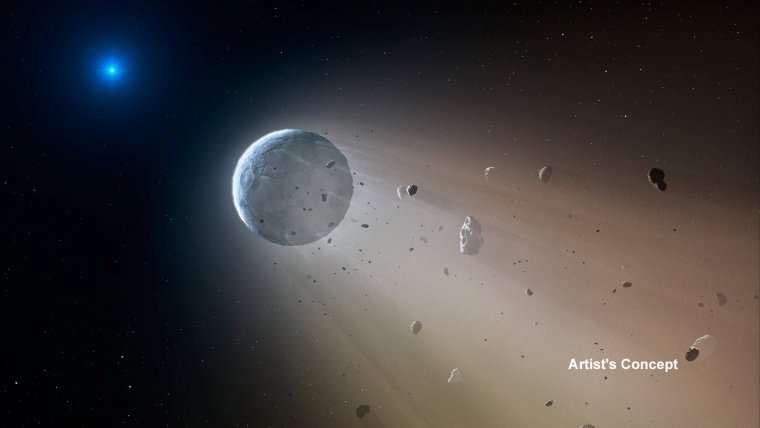| News / Space News |
K2 Finds Dead Star Vaporizing a Mini 'Planet'
NASA | NOVEMBER 3, 2015
Scientists using NASA's repurposed Kepler space telescope, known as the K2 mission, have uncovered strong evidence of a tiny, rocky object being torn apart as it spirals around a white dwarf star.

A tiny rocky object vaporizes as it orbits a white dwarf star (artist conception). ![]()
This discovery validates a long-held theory that white dwarfs are capable of cannibalizing possible remnant planets that have survived within its solar system.
As stars like our sun age, they puff up into red giants and then gradually lose about half their mass, shrinking down to 1/100th of their original size to roughly the size of Earth. This dead, dense star remnant is called a white dwarf.
During its first observing campaign, K2 trained its gaze on a patch of sky in the constellation Virgo, measuring the minuscule change in brightness of the distant white dwarf. When an object transits, or passes in front of a star from the vantage point of the space telescope, a dip in starlight is recorded.
While there was a prominent dip in brightness occurring every 4.5 hours, blocking up to 40 percent of the white dwarf's light, the transit signal of the tiny planet did not exhibit the typical symmetric U-shaped pattern. It showed an asymmetric elongated slope pattern that would indicate the presence of a comet-like tail.
Together these features indicated a ring of dusty debris circling the white dwarf, and what could be the signature of a small planet being vaporized.
Due to intense gravity, white dwarfs are expected to have chemically pure surfaces, covered only with light elements of helium and hydrogen. For years, researchers have found evidence that some white dwarf atmospheres are polluted with traces of heavier elements such as calcium, silicon, magnesium and iron.
Scientists have long suspected that the source of this pollution was an asteroid or a small planet being torn apart by the white dwarf's intense gravity.
YOU MAY ALSO LIKE

